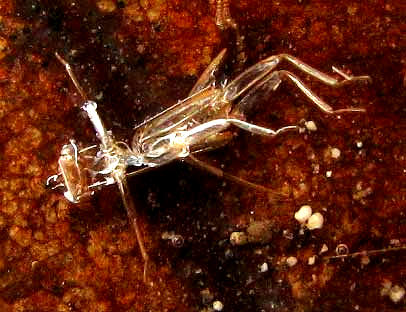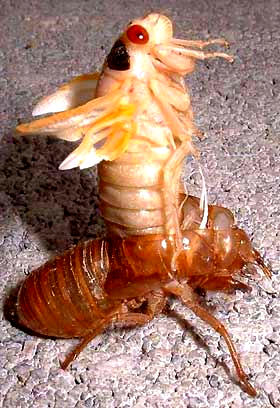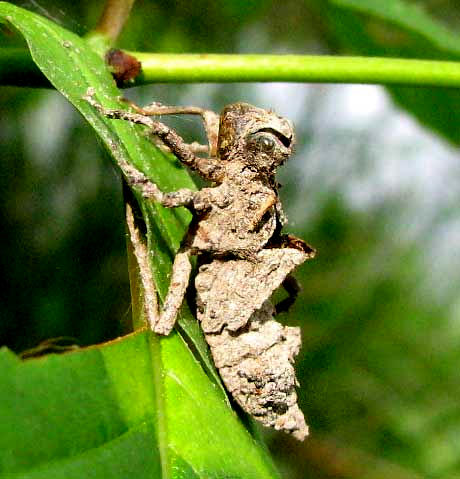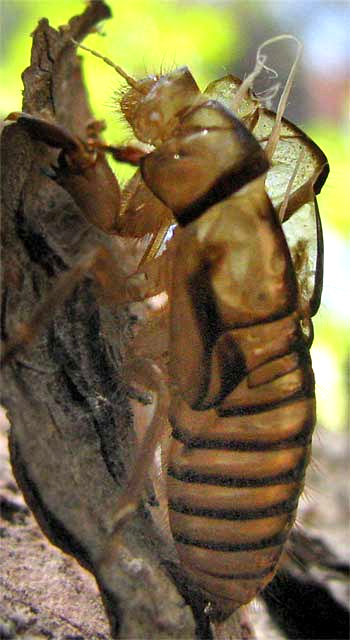
Sometimes you
run across something looking like the bleached-out ruins of a wrecked insect, similar to what you see below:

That's a stonefly's discarded exoskeleton, or "exuvia," and there's a story behind it.
In a sense, an insect has its skeleton outside its body. The insect's body wall is hardened (the technical term is sclerotized) so that it becomes like a shell over the insect's body. If you think about having your skeleton on the body's outside instead of the inside, eventually a question will occur to you. That is, "How do insects grow?" Wouldn't their hard exoskeleton keep them from getting larger?
 If you study the picture at the left, probably you'll figure out what they do. What they do is, every now and then as the insect grows, its exoskeleton actually splits open, and an enlarged edition of the insect emerges, leaving the old exoskeleton behind. That's what is happening with the periodical cicada at the left. That's what happened with the bush cricket's exoskeleton at the top of this page.
If you study the picture at the left, probably you'll figure out what they do. What they do is, every now and then as the insect grows, its exoskeleton actually splits open, and an enlarged edition of the insect emerges, leaving the old exoskeleton behind. That's what is happening with the periodical cicada at the left. That's what happened with the bush cricket's exoskeleton at the top of this page.
Below is another exoskeleton example, this time of a dragonfly nymph, a nymph being an immature stage of an insect undergoing incomplete metamorposis. Adult dragonflies fly in the air, but their immature stages occur underwater. The dragonfly nymph exoskeleton shown below is mud-covered because the nymph emerged from muddy water and climbed an aquatic plant's stem. Note the split-open parts across the head and back, where the adult emerged.

In our own bodies, muscles are attached to our skeleton's bones. A muscle contracts, pulling the bone toward it. Having lots of bones move about like that in a coordinated manner is how we move around. The insect's exoskeleton serves a similar purpose, with the insect's muscles attached to the inner surface of the exoskeleton. An insect's muscle contracts, causing the part of the exoskeleton attached to that muscle to move toward the muscle, enabling the insect to move about.
Unfortunately for insects, it takes a while for a new exoskeleton to harden, and during this time of having a soft exoskeleton the insect may be very vulnerable to predators.
Why would Mother Nature create insects with such a "built-in weakness"? Surely it's because during most of an insect's life its exoskeleton is of such great benefit that being vulnerable for a brief period several times in its life is a good trade-off.
When an insect emerges from its old exoskeleton, it is said to be molting. The stages between an insect's successive molts are referred to as instars.
Finally, so you won't get the idea that an insect breaking from its exoskeleton is as simple as a human taking off a coat, take a look at this:

That's an abandoned cicada exoskeleton. The white, thread-like items issuing from the husk's split-open back are left-behind linings of the insect's tracheae, which are more or less like a human's windpipe. Can you imagine having the lining of your windpipe torn out each time you grew into bigger clothing?
 If you study the picture at the left, probably you'll figure out what they do. What they do is, every now and then as the insect grows, its exoskeleton actually splits open, and an enlarged edition of the insect emerges, leaving the old exoskeleton behind. That's what is happening with the periodical cicada at the left. That's what happened with the bush cricket's exoskeleton at the top of this page.
If you study the picture at the left, probably you'll figure out what they do. What they do is, every now and then as the insect grows, its exoskeleton actually splits open, and an enlarged edition of the insect emerges, leaving the old exoskeleton behind. That's what is happening with the periodical cicada at the left. That's what happened with the bush cricket's exoskeleton at the top of this page.


